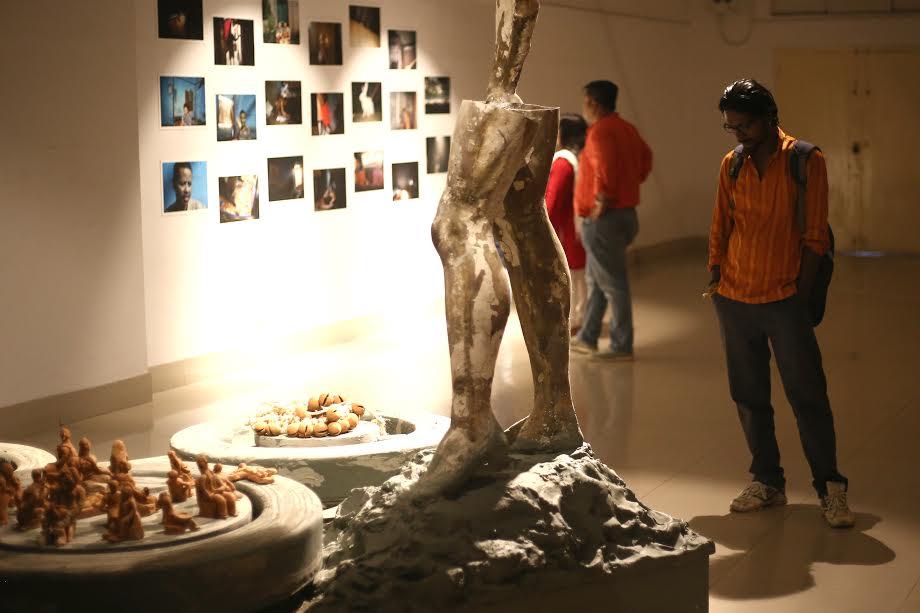 image
image
Chander Haat holds a multidisciplinary art exhibition 'Life and Time: The Changing Landscape
Kolkata, Apr 3 (IBNS): Kolkata based artists commune, Chander Haat held a multidisciplinary art exhibition entitled Life and Time: The Changing Landscape, at the Academy of Fine Arts, Kolkata, recently.
Present at the inauguration were Stephane Amalir, Director, Alliance Francaise du Bengale, Kolkata as the Chief Guest, Jogen Chowdhury, artist as Special Guest and Pranab Ranjan Roy, art historian as the Guest of Honour.
Pranab Ranjan Roy said, “Chander Haat is a very prime and worthy platform for all kinds of artists across the city. I am hoeful that it will grow higher and encompass with more forms of art and talents in future.”
Curated by art activist Probir Gupta, the exhibition featured 13 participating artists and 10 invited artists across the world.
The participating artists included Anjan Das, Ayan Saha, Bhabatosh Sutar, Dhiman Sutar, Mallika Das Sutar, Nirmal Malick, Pradip Das, Pintu Sikdar, Raju Sarkar, Sujit Das, Smita Das, Swastik Pal and Tarun Dey, and 10 invited artists – Bandu Manamperi (Sri Lanka), Dhali Al Mamoon (Bangladesh), Imran Hossain Piplu (Bangladesh),Kirstine Skov Hansen (Denmark), N. Pushpamala (India), Probir Gupta (India), Paul Holmes (UK), Shukla Sawant (India), Sara Acremann (France) and Valentina Sekisova (Russia).
Speaking to IBNS, Probir Gupta said,”Chander Haat has a great set up, a group well equipped to present exciting and the best artists.”
“The works in this exhibition are based on several contemporary aspects, from migration to health related issues, violence on women, discrimination and many other socially pertinent topics. That is why it has been named ‘Life and Time: the Changing Landscape,” he added.
Talking about his own work, he said, "I have been working with a community of women, who came from Bangladesh when they were very young. They were rather poor and also not able to get any education. They worked as domestic helps to earn a living and in the evening entertained themselves by singing in the Monosa Temple.”
"I have basically taken casts of their feet, and my work is a kind of composition of feet of these women, while they were singing. Therefore a music track is played as a background to the exhibit. So, it’s basically how these women came together to share their stories, creating bonds with other women and got a level of strength and confidence,” explained Gupta.
N. Pushpamala, a participating artist from Bangalore (India) shared the creative process of her work with IBNS. She said, “Good Habits is a very recent video I have made using medical models. I got them from medical supply shops. It’s a strange thing, I have become interested in Eugenics, which is the study of genes or pseudo science, which was quite popular at the beginning of the last century, and worst when Nazis used it to purify the race, trying to eliminate what they thought were the bad genes.”
She added, "Here my model is a bisexual and through her I am trying to analyze the notorious histories of anthropology, ethnography and eugenics that ironically define modernizing government projects with the dream of building an ideal community.”
Illustrated talks were presented by N. Pushpamala, Sanchayan Ghosh, Shukla Sawant and Sumona Chakravarty.
(Reporting by Aninnya Sarkar)
Top Headlines
-
Lifestyle
ACM India unveils National AI Olympiad 2026 to spot school talent for global AI stage
December 21, 2025
-
Lifestyle
'Dont join politics': Why Tharoor defied his mother and endorsed his conviction
December 15, 2025
-
Lifestyle
Birbhum: Sitaramdas Omkarnath Chair at Biswa Bangla Biswavidyalay
December 04, 2025
-
Lifestyle
Rediscovering Arunachal's Monpa Cuisine: One Womans Millet Momo Revolution
November 24, 2025
-
Lifestyle
Shiny things by Jinia: A luxury evolution by visionary entrepreneur, healer
November 19, 2025
-
Lifestyle
Mystique and Memories: Wiccan Brigade hosts its first Halloween Fest in Kolkata
November 17, 2025
-
Lifestyle
Rotary Club of Calcutta Samaritans hosts three-day youth leadership awards program for tribal students in Bakura
November 15, 2025
-
Lifestyle
Rotary Club, South Kolkata Vision inaugurate newly developed children's park in Sonarpur
November 15, 2025
-
Lifestyle
Bengali couple promoting Indian music and culture among young Americans
October 28, 2025
-
Lifestyle
Durga Puja sustainability: One of the oldest awards goes flex-free
October 17, 2025
